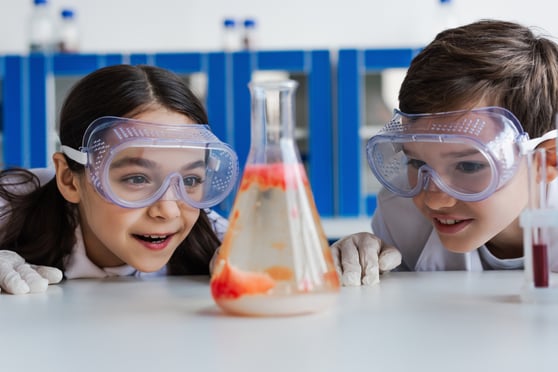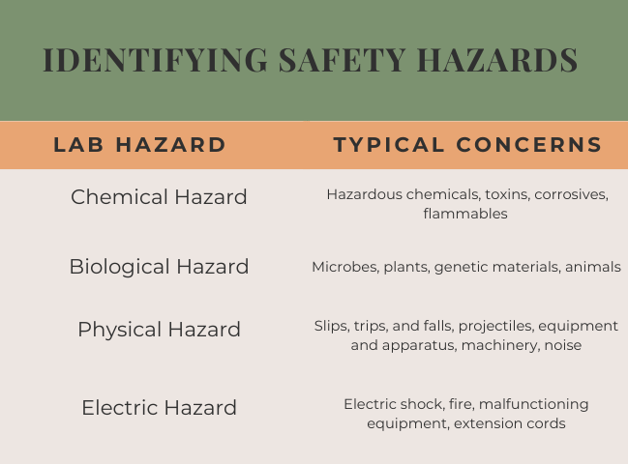
5 Easy Math Engagement Strategies for the Classroom
The news headlines are daunting. Math scores are down. School districts are scrambling to turn things around. And...
ALI Staff | Published October 18, 2023
Lab risk assessments are an important part of the STEM classroom. It’s a way to recognize existing and potential hazards, assess you and your students’ risk, and determine any actions that need to be taken to improve and assure science safety for everyone.
By understanding the dangers associated with experiments, science equipment, and hazardous chemicals, teachers can be proactive about minimizing risk and preventing accidents. It’s also important to help students feel ownership over their responsibilities in the science classroom.
Science safety is a group effort, and students’ awareness of safety standards is a critical piece of that. Before you and your students can adopt a safety-first mindset, though, it’s important to understand what you’re looking for that could make a science space unsafe.

The following questions can be an informal gauge of your personal safety starting point. These are questions for school administrators, as well, particularly at STEM schools that prioritize inquiry-based learning:
If you’re not sure about any of your answers here but running a science lab, it’s important to gather that information so that you’re able to identify potential gaps in your safety program.
Safety awareness and training is the best way to identify potential hazards in your STEM classroom and prevent possible accidents or injuries. A hazard analysis or safety risk assessment is a good place to start before any science activity.
Let’s look at a few different health hazard examples and typical concerns:

It isn’t enough to know about potential hazards, though. It’s important to know what to do with those risks and how to act on even an informal hazard risk assessment. That’s where the AAA method comes in.
Teachers can make science labs safer by following a set of safety standards known as the analysis, assessment, and action (AAA) method. The method is endorsed by the National Science Teaching Association (NSTA) Safety Advisory Board as the best way to protect everyone in the science classroom.
Let’s take a closer look at the three steps of the AAA method.
Before any science lab, teachers should perform a hazard analysis to determine potential hazards at play. We’ve already talked about the different kinds of hazards possible in a STEM classroom: chemical, biological, physical, and electrical.
A hazards analysis can be approached in a variety of different ways, but it depends on a teacher’s experience with the lab. Any new teachers should undergo science safety trainings and learn how to complete Safety Data Sheets (SDSs) and CHPs.
SDSs and CHPs are both used when there are any hazardous chemicals involved in a science experiment. Proper use of these tools is part of the Occupational Safety and Health Administration’s (OSHA’s) rules for exposure to hazardous chemicals in labs. Any OSHA risk assessment will prioritize hazardous chemicals as part of overall lab safety.
Quick note: OSHA health hazards also include ergonomic and organizational hazards that we won’t detail here. Those are more relevant to workplaces, something that teachers should be aware of for their own well-being, but that is not relevant to student science safety.
After a detailed analysis of the lab, it’s time to assess the risk of any potential hazards determined by that analysis. Pay attention to the following sections of your SDSs:
From here, you can decide which areas need action to improve safety in your lab.
Step 3: Action
You’ve analyzed risks in your lab based on OSHA hazards and completed a hazard assessment. Now it’s time to act. The actions you take will be based on OSHA’s Hazard Prevention and Control standards. Those include:
In most cases, Section 8 of your SDS can help you come up with health and safety supports, but sometimes, a lab or other hands-on activity is just too risky. If that’s what comes out of the AAA method, you’ll need to come up with a safer alternative for you and your students.
That last step of the AAA method is the most tangible, but it can be daunting to know where to start if your lab could use a tune-up. There are a few general steps you can take to ensure a safe science environment. We call them the “Big 6.” Here’s where to start:
1. Review SDSs for safety concerns and identify possible risk areas, including health, handling, storage, flammability, and toxicology.
2. Review all equipment, materials, apparatus, tools, and machinery involved with the planned activity.
3. Review procedures and materials, concentration, timing, sequence, waste management, and emergency procedures.
4. If you have not performed the activity before, test-drive the experiment with a colleague at your school and evaluate unexpected hazards, results, or risks.
5. Allow for substitutions of hazardous chemicals while meeting curriculum standards.
6. Ask if the educational value of doing the activity outweighs the risks.
That last action deserves a little more attention. There are some items that have a greater inherent risk than any possible educational benefit. These include:
*Any mercury-containing items in your lab should be replaced!
It’s always important that the classroom is a safe space for learning in the figurative sense. Students need to be able to make mistakes, ask questions, and challenge themselves without judgment.
Before they can even get there, though, there needs to be a high level of physical safety, too, especially in STEM classrooms. A physically safe classroom allows students to focus on the hands-on activities in front of them without fear. It instills responsible behavior and teaches students the value of precaution and preparation.
On the teacher side, it allows teachers to focus on differentiating instruction and supporting students through a science lab rather than stressing about potential accidents. A safe classroom is a classroom where more learning can happen without interruption.

The news headlines are daunting. Math scores are down. School districts are scrambling to turn things around. And...

Math assessment in California is changing. What used to be a compliance exercise or reporting tool is now becoming a...

You know the moment: a student’s eyes light up when the science experiment fizzes or the math puzzle helps them...